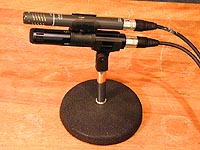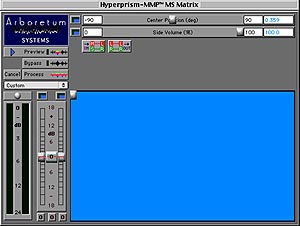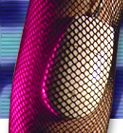I needed
to record some background ambients for this project (alt.sex)
and wanted them to be in stereo, to give the soundtrack a little
wider sound than just all the voices panned in the center. In
the past, if I wanted to do stereo, I'd just get a couple of
omni mics and cross them in an "x" pattern and away I'd go.
I guess the deal with the "X" pattern is they generally end
up about as wide as someone's head, and that's how one normally
hears stereo sounds in real life.
One
of the "problems" of recording stereo this way is that you *CAN*
get phasing problems by having a sound hit one mic a few milliseconds
before the other side does. (it *SOMETIMES* cancels out certain
frequencies and you end up with thin, tinny or strange sounding
audio.) The other problem is that you can get a "deader" spot
in the direct middle of your recording because the center portion
is where the sound drops off (or is off axis) from the mics.
Since none of the mics are pointing towards the center portion
of your audio field, you won't be getting a good picture of
what's there. (even though SOMETHING will be recorde. Enter
M-S Stereo. (Mid-Side stereo) I'm gonna try 'n explain it as
best as I think I know how.
How
it's done.
 You
use a cardiod (preferably something like a Sennheiser
MKH-40, I've been using my hyper-cardiod MKH-50)
microphone along with a figure-8 microphone (I have an AKG
SE300 power module/CK 94 mic head combo) and stack them
one on top of each other. The figure-eight microphone records
signals directly out to the sides (180 degrees in the shape
of a figure-eight) and your cardiod focuses on what's going
on in the middle. You record both mics separately onto a DAT.
What you have now is something that sorta sounds like stereo,
but everything in the middle comes out of one speaker, and everything
from the sides comes from the other.
You
use a cardiod (preferably something like a Sennheiser
MKH-40, I've been using my hyper-cardiod MKH-50)
microphone along with a figure-8 microphone (I have an AKG
SE300 power module/CK 94 mic head combo) and stack them
one on top of each other. The figure-eight microphone records
signals directly out to the sides (180 degrees in the shape
of a figure-eight) and your cardiod focuses on what's going
on in the middle. You record both mics separately onto a DAT.
What you have now is something that sorta sounds like stereo,
but everything in the middle comes out of one speaker, and everything
from the sides comes from the other.
You
now have to MATRIX the signal. (fear not, you won't be popping
out of a pod with goo all over you) I'm gonna try 'n explain
how I think it's done. Check some of the links at the bottom
of this page to read what is actually going on. When you matrix
a pair of M-S signals, you take the figure-eight WIDE audio
and double it, flip the phase of one of these channels and combine
both with the mono center channel of your cardiod mic signal.
What you end up with is a super wide stereo field of audio that
has good definition in the middle along with the sides.
The
tricky part to understand is how you get TWO signals out of
one (mono) figure-eight microphone. A figure-eight microphone
has one sound recording diaphragm within it, but it's pointing
perpendicular/out to the sides of this microphone. To record
audio, the diaphragm goes "back and forth" when sound hits it
from either direction. Sound from one side pushes it one way,
sound from the other side pushes it back. Once you've doubled
this signal, you flip the phase of one side, or "take whatever
sound that pushed the diaphragm in one direction, and extract
it from whatever pushed the diaphragm back the other way." Both
signals are said to be "out of phase" from each other and will
cancel each other out if you sum the two together as a mono
signal. (similar problem that we had with the "X" mic configuration,
but it works with what we're doing because we're taking two
entirely different sound sources, an extreme left and right,
and playing them back through stereo speakers, and not just
one speaker per se.)
So
why should I bother with M-S recording?
1.
What you end up with is a completely mono compatible signal.
The figure-eight signal completely disappears when you play
everything through a mono system. (like...A TV SET!) You won't
end up with funky, out-of-phase background audio which could
completely disappear on you. You'll at least have a good signal
of what the middle microphone was point at.
2.
You end up with audio which appears in the rear channel of a
surround sound system! Because of the phasing that is going
on with M-S matrixing, it causes surround systems to think that
the signal is part of the rear channel. I'm not referring to
the Dobly 5:1 channel or DTS surround, but Dolby Pro-Logic set-ups.
This can either be good or bad. If you DON'T want the signal
to come out the rear speakers, you have to mix everything on
a surround sound capable mixing system. Since I'm a pathetic
indie guy with no budget to do a full-blown surround mix, I
can FAKE like I did a surround mix by using a M-S matrixed audio!
3.
You have more options after the fact. You can decide how wide
the audio spread should be after you've recorded your sound.
(This is done during the Matrixing.) Also...if for some reason
you DON'T want to use a full 180 degree field of audio, but
just want was happening in front of you, you CAN only use the
cardiod mic and nothing else. A good example of this would be
your recording sound effects in the field, you come upon something
like a cricket, and you want the sound of the cricket and NOT
the entire forest around you. You have the option of only using
the middle cardiod signal. If you've been recording everything
with an "X" configuration, you'll have to go with a wide signal
or nothing.
So
how do I do this Matrixing? (without waking up in a puddle
of goo with wires attached to your body)
 In
the past, you had to shell out a couple of hundred bucks for
a little box that took both signals and did it's magic before
you sent it into your mixer. The other way was to do the split/reverse
phase/pan and mix with the middle on a mixing board. (You had
to have something that could flip the phase of a channel, some
mixers could do this, or you can get a little doo-hickey phase
shifter plug.)
In
the past, you had to shell out a couple of hundred bucks for
a little box that took both signals and did it's magic before
you sent it into your mixer. The other way was to do the split/reverse
phase/pan and mix with the middle on a mixing board. (You had
to have something that could flip the phase of a channel, some
mixers could do this, or you can get a little doo-hickey phase
shifter plug.)
Since
I digitally transfer everything into a computer anyways, the
easiest and cheapest way is to use a plug-in for a sound program.
I use Peak (an audio application on the Macintosh) and the Hyperprism
VST Matrix M-S plug-in. I'm pretty sure that there are a
couple of different plug-ins that do M-S matrixing, but this
is the one that I've "found" first.
What
other options are there for recording M-S stereo audio?
The
CHEAPEST way to record M-S stereo is to use the Shure
VP-88 stereo microphone. This mic is a piece of shit. I
bought one online and thankfully I was able to send it back.
The thing is heavy and huge and sounds nice, but the side channel
is COMPLETELY NOISY. I'm talking about "what IS that? TAPE HISS
coming out of my mic?" Unless you want to record a rock concert
or drum cymbals, avoid this mic.
All
the other mics seem to start around a grand and go WAY up. Check
out the list of links at the bottom of the page. Since I already
had the MKH-50, I used that and bought an AKG
Blue Line figure-eight mic. There aren't too many figure-eight
microphones out there. (Note: I did do tests with an AKG C414
large diaphragm mic. It has a figure-eight pattern built into
it. I got it to do M-S stereo with my MKH-50, but it sure was
awkward going out into the field with that set-up!) One of the
best ones is the Sennheiser
MKH-30. This will put you back about $1300. The AKG Blue
Line mics are modular, so you swap the heads and use it for
other things. My AKG Se 300/CK 94 only cost me $500. (The figure-eight
capsule is the most expensive one they have.) You can easily
buy a whole M-S AKG Blue Line rig for about $800. The CK94 figure-eight
head seems to be nice 'n quiet, pretty close to my MKH-50 in
noise level. If you want to record birdies chirping and wind
blowing through the trees, you'll need a pair of quiet mics.
One
last thing, the handy-dandy mic clips which hold the two micrphones
together are:
Sennheiser
MZD 30 dual mic clip or the AKG H300 dual mic clip. Both cost
about $60. The AKG H300 rotates so you can use it either in
an X-Y pattern or an M-S set-up. I think the MZD 30 is designed
to be used inside of their Sennheiser zeppelin housing. I think
it has little hooks so you can attach it with rubber bands to
the inside of the zeppelin/blimp.
Quick
update 12/25/05:
I noticed
that audio recorded like this does some weird things
when played back in a surround sound environment. Check it
out if you have the chance. Seems to do some weird phasing
between the mics which screws with the older surround matrix.
(Dolby Pro Logic)







